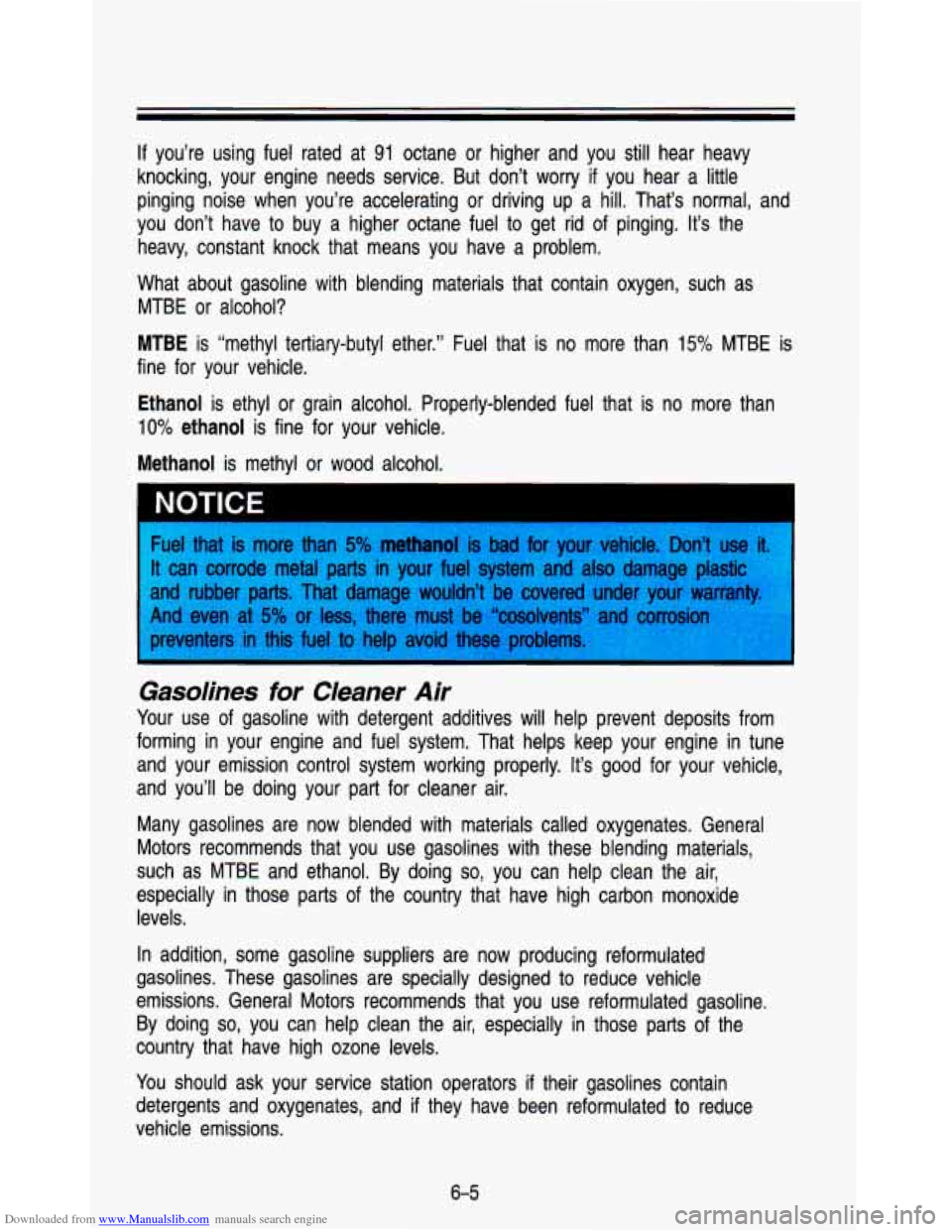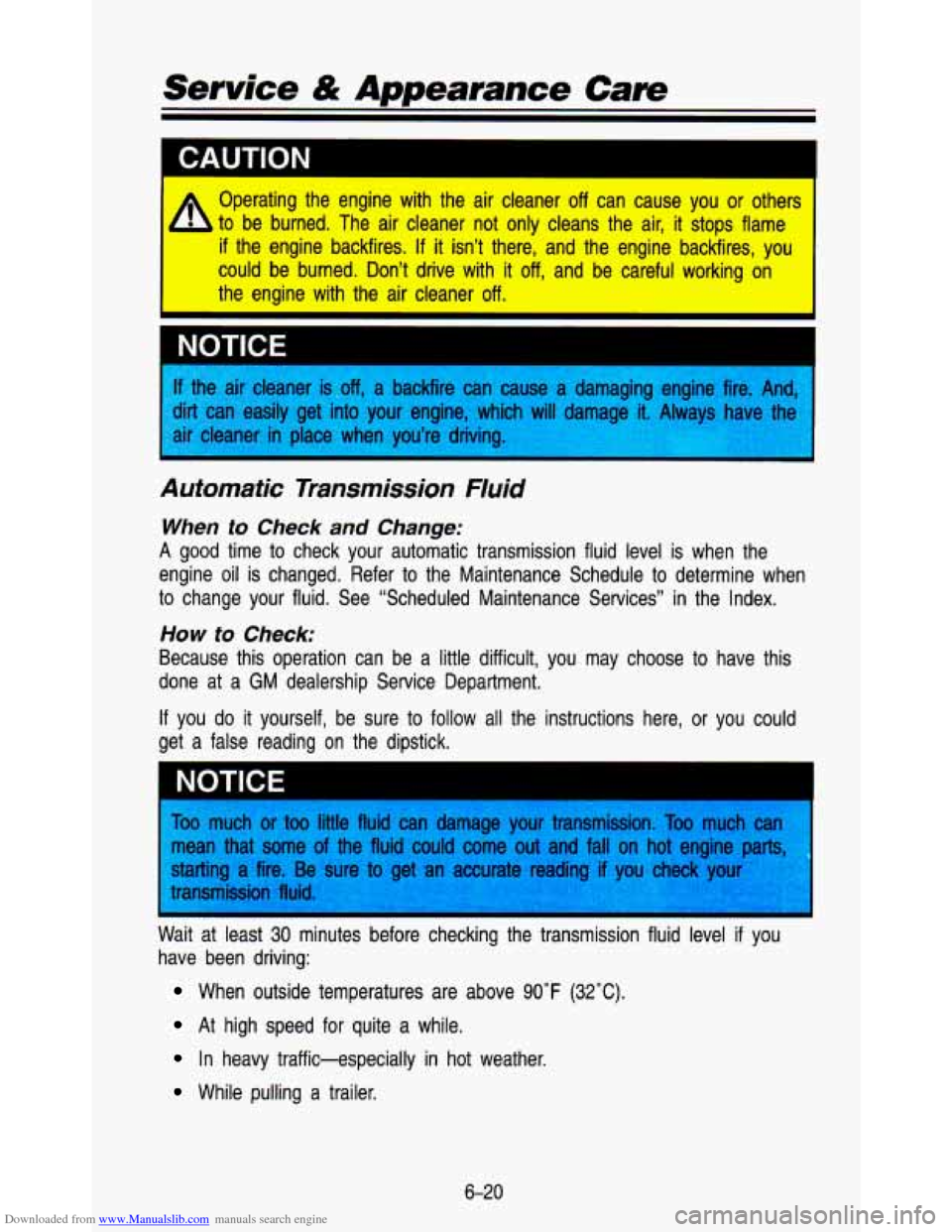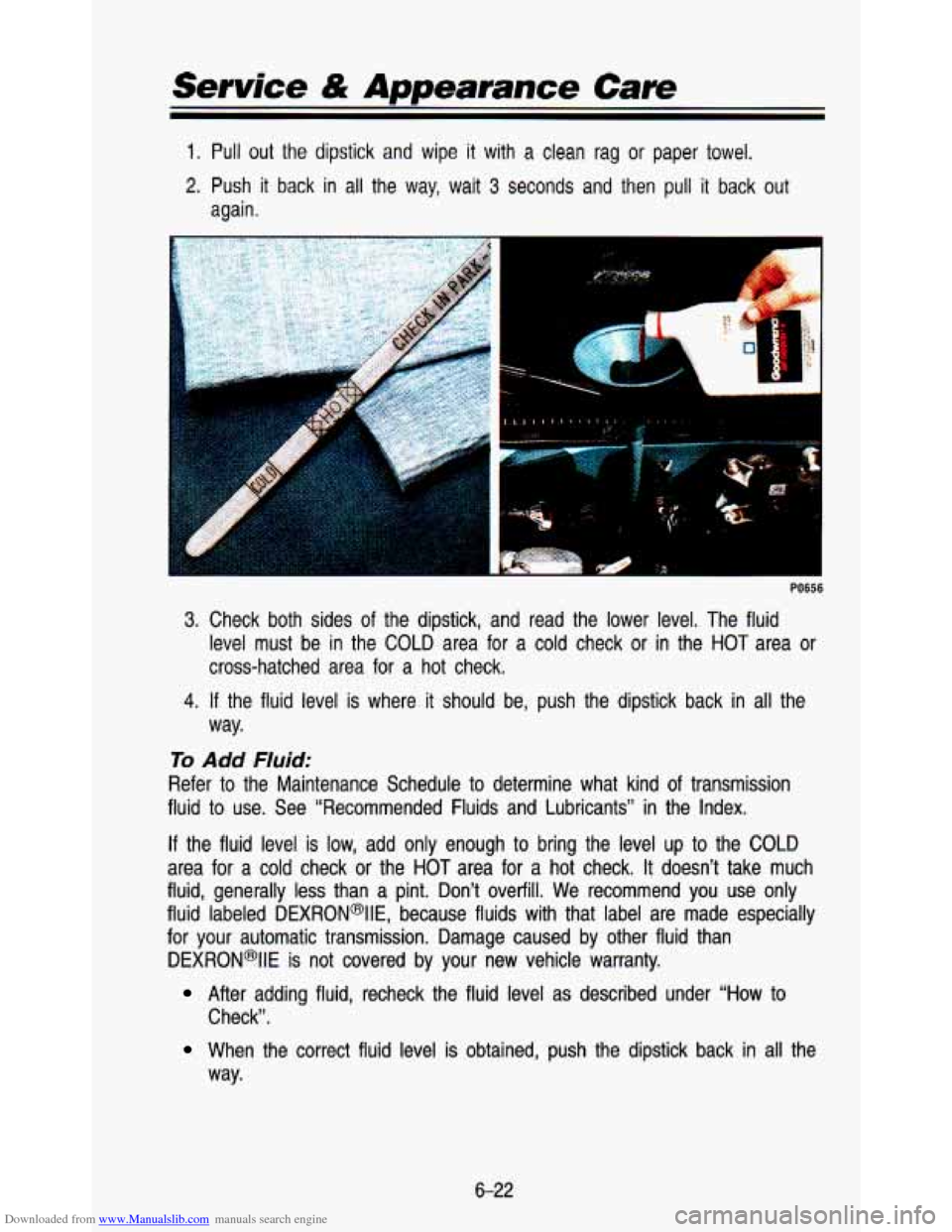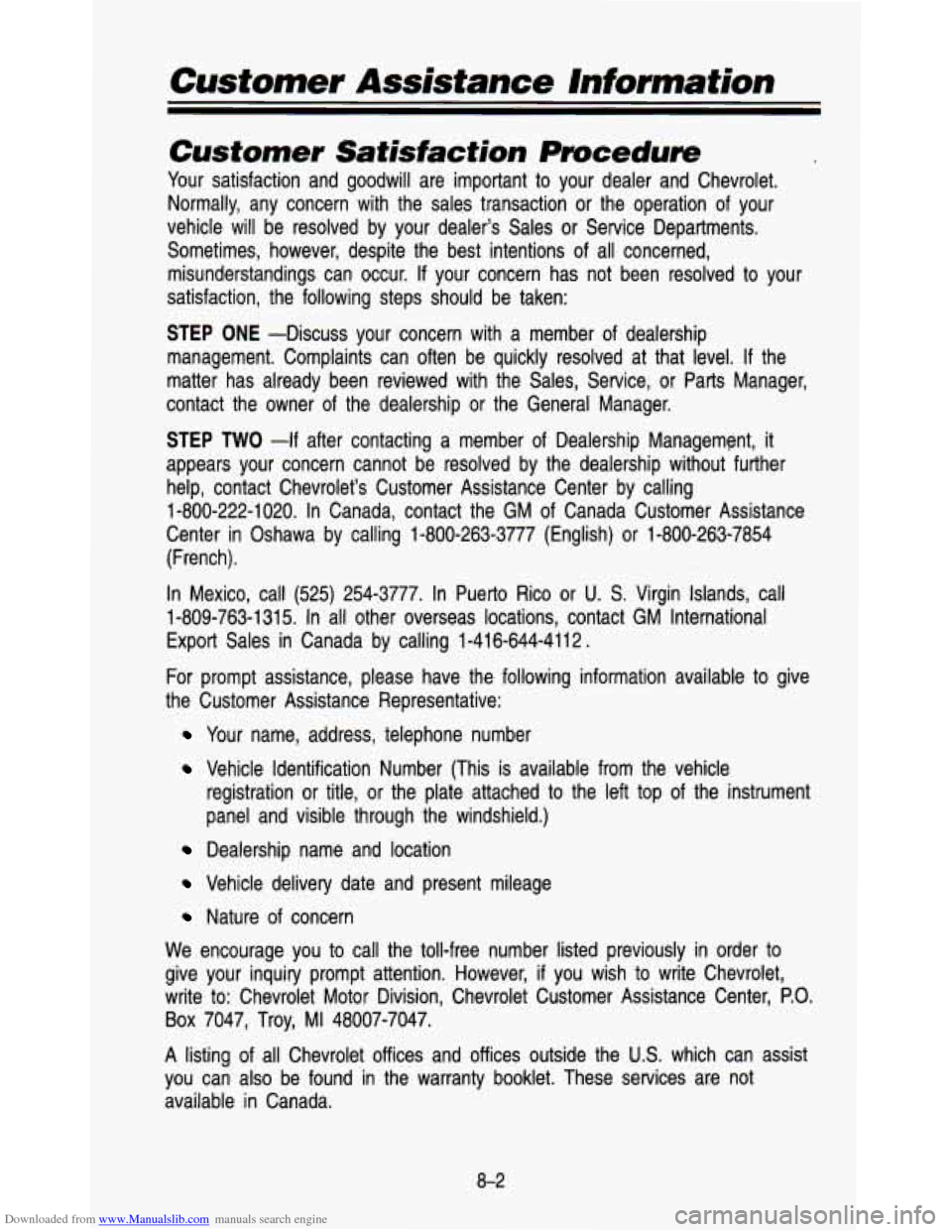1993 CHEVROLET ASTRO PASSENGER ESP
[x] Cancel search: ESPPage 241 of 345

Downloaded from www.Manualslib.com manuals search engine If you’re using fuel rated at 91 octane or higher and you still hear heavy
knocking, your engine needs service. But don’t worry if you hear a little
pinging noise when you’re accelerating or driving up a hill. That’s normal, and
you don’t have to buy a higher octane fuel to get rid of pinging. It’s the
heavy, constant knock that means you have a problem.
What about gasoline with blending materials that contain oxygen,\
such as MTBE
or alcohol?
MTBE is “methyl tertiary-butyl ether.” Fuel that is no more th\
an 15% MTBE is
fine for your vehicle.
Ethanol is ethyl or grain alcohol. Properly-blended fuel that is no more than
10% ethanol is fine for your vehicle.
Methanol is methyl or wood alcohol.
Fuel that is more than
5% methanol is bad for your vehicle. Don’t use It.
It can corrode metal parts in your fuel system and also damage plastic
and rubber parts. That damage wouldn’t be covered under your\
warran
And even at 5% or less, there must be “cosolvents” md cc----6io
preventers in this fuel to help avoid these problems
Gasolines for CIeaner Air
Your use of gasoline with detergent additives will help prevent deposits fro\
m
forming in your engine and fuel system. That helps keep your engine in tune
and your emission control system working properly. It’s good \
for your vehicle,
and you’ll be doing your part for cleaner air.
Many gasolines are now blended with materials called oxygenates.\
General
Motors recommends that you use gasolines with these blending ma\
terials,
such as MTBE and ethanol. By doing
so, you can help clean the air,
especially in those parts of the country that have high carbon monoxide
levels.
In addition, some gasoline suppliers are now producing reformulated \
gasolines. These gasolines are specially designed to reduce vehicle
emissions. General Motors recommends that you use reformulated g\
asoline.
By doing
so, you can help clean the air, especially in those parts of the
country that have high ozone levels.
You should ask your service station operators
if their gasolines contain
detergents and oxygenates, and
if they have been reformulated to reduce
vehicle emissions.
6-5
Page 256 of 345

Downloaded from www.Manualslib.com manuals search engine Service & Appearance Care
h
Operating the engine with the air cleaner off can cause you or other!
to be burned. The air cleaner not only cleans the air, it stops flame
if the engine backfires. If it isn’t there, and the engine backfires, you
could be burned. Don’t drive with it off, and be careful working on
the engine with the air cleaner off.
If the air cleaner is off, a backfir
dirt can easily get into your engine,
air cleaner in place when you’re drivin $use a damaging engir
hicl
vill damage it. Na)
Automatic Transmission Nuid
When to Check and Change:
A good time to check your automatic transmission fluid level is when the
engine oil is changed. Refer to the Maintenance Schedule
to determine when
to change your fluid. See “Scheduled Maintenance Services” in the Index.
How to Check:
Because this operation can be a little difficult, you may choo\
se to have this
done at a
GM dealership Service Department.
If you do it yourself, be sure to follow all the instructions here, or you could
get a false reading on the dipstick.
Too much or too little fluid can damage your transmission. Too much can
mean that some of the fluid could come out and fall on hot engine part-
starting a fire. Be sure to get an accurate reading
if you check your
transmission fluid.
I
I
Wait at least 30 minutes before checking the transmission fluid level if you
have been driving:
When outside temperatures are above 90°F (32°C).
At high speed for quite a while.
In heavy traffic-especially in hot weather.
While pulling a trailer.
6-20
Page 258 of 345

Downloaded from www.Manualslib.com manuals search engine Service & Appearance Care
1. Pull out the dipstick and wipe it with a clean rag or paper towel.
2. Push it back in all the way, wait 3 seconds and then pull it back out
again.
3. Check both sides of the dipstick, and read the lower level. The fluid
level must be in the COLD area for a cold check or in the
HOT area or
cross-hatched area for a hot check.
way.
4. If the fluid level is where it should be, push the dipstick back in all the
To Add Fluid:
Refer to the Maintenance Schedule to determine what kind of transmission
fluid
to use. See “Recommended Fluids and Lubricants” in the Index.
If the fluid level is low, add only enough to bring the level up to the COLD
area
for a cold check or the HOT area for a hot check. It doesn’t take much
fluid, generally less than a pint. Don’t overfill. We recommend you use only
fluid labeled DEXRON@IIE, because fluids with that label are ma\
de especially
for your automatic transmission. Damage caused by other fluid t\
han DEXRON*IIE
is not covered by your new vehicle warranty.
After adding fluid, recheck the fluid level as described under “How to
Check”.
When the correct fiuid level is obtained, push the dipstick back in all the
way.
6-22
Page 286 of 345

Downloaded from www.Manualslib.com manuals search engine failure. The grade C corresponds to a level of performance which all
passenger car tires must meet under the Federal Motor Vehicle \
Safety
Standard
No. 109. Grades B and A represent higher levels of performance on
the laboratory test wheel than the minimum required by law.
Warning: The temperature grade for this tire is established for\
a tire that is
properly inflated and not overloaded. Excessive speed, underinfla\
tion,
or
excessive loading, either separately or in combination, can cause heat buildup
and possible tire failure.
These grades are molded on the sidewalls of passenger car tire\
s.
While the tires available as standard
or optional equipment on General Motors
vehicles may vary with respect to these grades, all such tires meet General
Motors performance standards and have been approved for use on \
General
Motors vehicles.
All passenger type (P Metric) tires must conform to Federal
safety requirements in addition to these grades.
Wheel Alignment and lire Balance
The wheels on your vehicle were aligned and balanced carefully \
at the
factory to give you the longest tire life and best overall pe\
rformance.
In most cases, you will not need
to have your wheels aligned again.
However,
if you notice unusual tire wear or your vehicle pulling one way or
the other, the alignment may need to be reset. If you notice your vehicle
vibrating when driving on a smooth road, your wheels may need \
to be
rebalanced.
Wheel Replacement
Replace any wheel that is bent, cracked or badly rusted. If wheel nuts keep
coming loose the wheel, wheel
bolts, and wheel nuts should be replaced. If
the wheel leaks air out, replace it (except some aluminum whe\
els, which can
sometimes be repaired). See your GM dealer if any of these c\
onditions exist.
Your dealer will know the kind of wheel you need.
Each new wheel should have the same load carrying capacity dia\
meter, width,
offset, and be mounted the same way as the one
it replaces.
If you need to replace any of your wheels, wheel bolts, or wheel nuts,
replace them only with new GM original equipment parts. This way, you will
be sure you have the right wheel, wheel bolts, and wheel nuts\
for your
vehicle.
6-50
Page 326 of 345

Downloaded from www.Manualslib.com manuals search engine Cusfomer Assistance hformafion
Customer Satisfaction Pmcedum
Your satisfaction and goodwill are important to your dealer and Chevrolet.
Normally, any concern with the sale,s transaction or the operation of your
vehicle will be resolved by your dealer’s Sales or Service \
Departments. Sometimes, however, despite the best intentions
of all concerned,
misunderstandings can occur.
If your concern has not been resolved to your
satisfaction, the following steps should be taken:
STEP ONE -Discuss your concern with a member of dealership
management. Complaints can often be quickly resolved at that le\
vel.
If the
matter has already been reviewed with the Sales, Service, or P\
arts Manager,
contact the owner
of the dealership or the General Manager.
STEP TWO -If after contacting a member of Dealership Management, it
appears your concern cannot be resolved by the dealership witho\
ut further help, contact Chevrolet’s Customer Assistance Center by calling
1-800-222-1 020. In Canada, contact the GM of Canada Customer Assistance
Center in Oshawa by calling 1-800-263-3777 (English)
or 1-800-263-7854
(French).
In Mexico, call (525) 254-3777.
In Puerto Rico or U. S. Virgin Islands, call
1-809-763-1 315. In all other overseas locations, contact GM In\
ternational
Export Sales in Canada by calling 1-416-644-4112
.
For prompt assistance, please have the following information ava\
ilable to give
the Customer Assistance Representative:
Your name, address, telephone number
Vehicle Identification Number (This is available from the vehicle
registration or title, or the plate attached to the left top of the instrument
panel and visible through the windshield.)
Dealership name and location
Vehicle delivery date and present mileage
Nature of concern
We encourage you to call the toll-free number listed previously in order to
give your inquiry prompt attention. However,
if you wish to write Chevrolet,
write to: Chevrolet Motor Division, Chevrolet Customer Assistance\
Center, P.O.
Box 7047, Troy,
MI 48007-7047.
A listing
of all Chevrolet offices and offices outside the U.S. which can assist
you can also be found in the warranty booklet. These services \
are not
available in Canada.
8-2